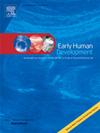出生时臀位对中度和晚期早产儿的神经发育结局有短期影响,但没有长期影响
IF 2
3区 医学
Q2 OBSTETRICS & GYNECOLOGY
引用次数: 0
摘要
目的探讨中晚期早产儿(MLPT)出生时胎位对其产后自主运动、体位和神经发育结局的影响。方法研究人群包括154名婴儿(55%为男婴,55%为单胎),其中33名(21%)为臀位分娩。在新生儿期和足月后3-4个月,采用新生儿一般运动最优性评分(GMOS)和随后的运动最优性评分-修订(MOS-R)进行分类Prechtl一般运动评估(GMA)和运动功能详细评分。神经发育在一年后使用Bayley-III评估。结果臀位出生的婴儿更容易出现病理性GMs (p = 0.05),下肢僵硬增加(p <;0.01)。足月后3-4个月的详细运动评估(MOS-R)显示,臀位出生的婴儿得分低于出生时头位出生的婴儿。分娩时的胎儿外观对12个月时的神经发育结果没有影响。结论出生时臀位会影响出生后早期的GMs和运动评估,但对一年后的神经发育结果无持续影响,提示对下肢运动有短暂影响。鉴于新生儿四肢僵硬是一个警报信号,可能与同步GMs局促有关,表明脑瘫的风险增加,在新生儿神经运动评估中应考虑胎儿出生时的表现。本文章由计算机程序翻译,如有差异,请以英文原文为准。
Breech presentation at birth has short-term but no long-term effect on neurodevelopmental outcome in moderate and late preterm infants
Aim
To investigate the effects of fetal presentation at birth on spontaneous postnatal movements, postures and neurodevelopmental outcome in moderate and late preterm (MLPT) infants.
Methods
The study population comprised 154 infants (55 % male, 55 % singletons) of whom 33 (21 %) were born in breech presentation. During the neonatal period and at 3–4 months post-term age, categorical Prechtl general movements assessment (GMA) and detailed scoring of motor functions was performed by means of the General Movement Optimality Score (GMOS) neonatally and Motor Optimality Score-Revised (MOS-R) later. Neurodevelopment was assessed at one year using Bayley-III.
Results
Infants born in breech presentation more frequently exhibited pathological GMs (p = 0.05) with increased stiffness in the lower extremities (p < 0.01) at neonatal age. Detailed motor assessments at 3–4 months post-term age (MOS-R) showed lower scores in infants born in breech compared to those with cephalic presentation at birth. Fetal presentation at the time of delivery did not impact neurodevelopmental outcomes at 12 months.
Conclusion
Breech presentation at birth affected GMs and movement assessments in the early postnatal period but had no persistent impact on neurodevelopmental outcomes at one year, suggesting a transient effect on lower extremity movements. Given stiffness in the extremities in neonates is an alarm sign and might relate to cramped synchronized GMs indicating an increased risk for cerebral palsy, fetal presentation at birth should be taken into consideration in neonatal neuromotor assessments.
求助全文
通过发布文献求助,成功后即可免费获取论文全文。
去求助
来源期刊

Early human development
医学-妇产科学
CiteScore
4.40
自引率
4.00%
发文量
100
审稿时长
46 days
期刊介绍:
Established as an authoritative, highly cited voice on early human development, Early Human Development provides a unique opportunity for researchers and clinicians to bridge the communication gap between disciplines. Creating a forum for the productive exchange of ideas concerning early human growth and development, the journal publishes original research and clinical papers with particular emphasis on the continuum between fetal life and the perinatal period; aspects of postnatal growth influenced by early events; and the safeguarding of the quality of human survival.
The first comprehensive and interdisciplinary journal in this area of growing importance, Early Human Development offers pertinent contributions to the following subject areas:
Fetology; perinatology; pediatrics; growth and development; obstetrics; reproduction and fertility; epidemiology; behavioural sciences; nutrition and metabolism; teratology; neurology; brain biology; developmental psychology and screening.
 求助内容:
求助内容: 应助结果提醒方式:
应助结果提醒方式:


